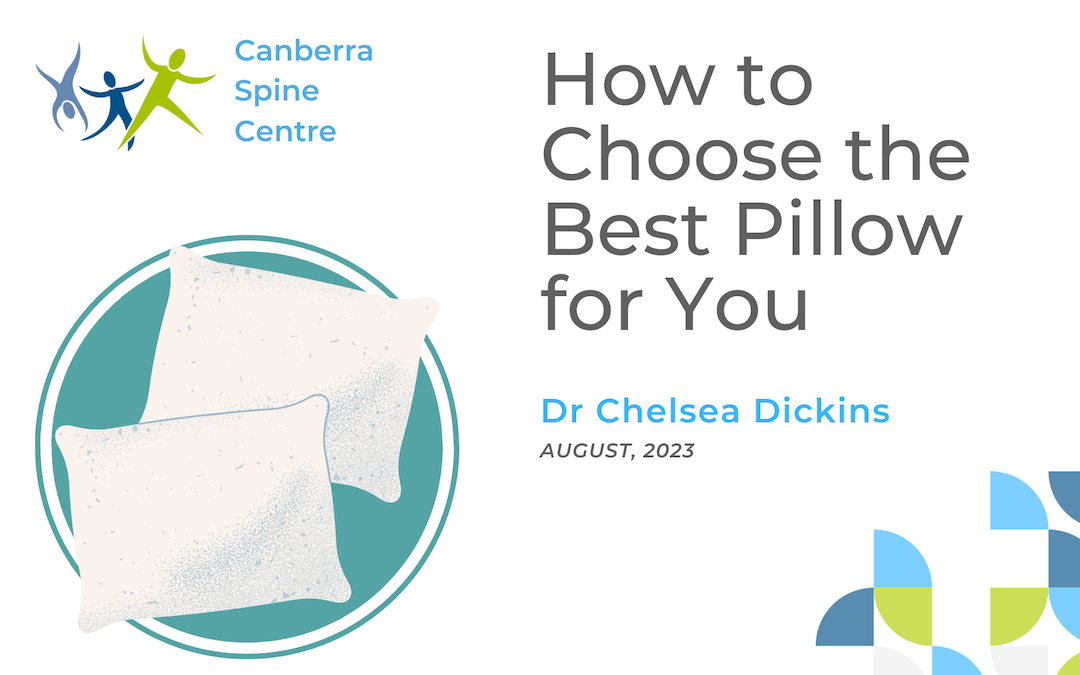
Where do I start?
This is a question that we get on a regular basis in our office.
There are so many types of pillows on the market! How are you meant to know which is best for you?
There are many signs that a pillow may be a part of the picture in driving your symptoms when you present to a chiropractor.
I will often bring up the topic of a pillow if we see a recurring pattern in a patient.
For instance, if only one side of their neck is always irritated and they are a side sleeper, this could be an indication that the pillow is involved being either too high or too low.
Biggest driver of pillow choice: sleep position
If you sleep in one position only, you are the easiest type of person to find a pillow for.
This is because the height that you require will always be the same. There are definitely some general rules of what to look for.
Back Sleepers – low profile
We are looking for a low pillow that keeps your spine in neutral. Multiple or thick pillows can push your head forward and be detrimental to your neck curve.
It also makes it harder for your body to get into a deep sleep as your nervous system stays in the fight and flight response. This is because your head is forward instead of relaxed in neutral.
Side sleepers – high profile
The height of the pillow needs to adequately fill between your shoulder and the side of your head.
A contour pillow is a great option for side sleepers, because of that natural curve which will support the spine in neutral.
To find if the pillow is the right height for side sleepers, you’ll need another person to look at your spine from behind.
Is your spine straight? Is your head tilted high or low? We want to see the neutrality, which tells us that your pillow is the right height.
Tummy Sleepers
It is generally the least preferred position because of the torsion required at your neck to allow breathing.
This position is not recommended. However to minimize irritation, the lowest lying pillow you can find would be the best option.
Combination sleepers
always the most difficult to fit. You need a pillow that can adapt between a low and high profile.
Some people find a contour is great, but they have to wake up to change position and then rotate their pillow. It is far from the best solution.
There are pillows on the market that will adapt. A water-based pillow will allow this dynamic change that you can sleep through changing positions.
How long should I have my pillow for?
Pillows should also be changed on a regular basis. Most pillows will come with a recommendation of life span.
Most sit between the 1-3 year mark. This may make your squirm depending on how long you may have had yours.
Another good thing to remember is when trying a new pillow, you should give a good one month trial to get used to it.
It may be quite a change from your last one, so stick with it, so long as the rest of criteria is being met.
There’s so many options!
There are so many pillow materials because different things work for different individuals. There may be a few attempts required to find your perfect match.
In terms of pillow material I am generally less concerned. Your comfort and choice is very important as it is you that will be spending around 1/3 of your life on it.
We want to provide a guide to set you up for success with the right height.
Once you’ve found the best pillow, don’t be shy to take it with you on road trips.
It can make such a difference to a good night’s sleep and if you have the space, it’s quite a practical item to pack!
Other things to look for. If you are a snorer, you should be screened for sleep apnoea.
Back sleepers tend to be the most likely candidates as the throat muscles collapse under gravity and this causes the temporary breaks in respiration.
A sleep apnoea test is very easy to acquire through your local pharmacy. You are able to attach it to yourself and it requires 4 hours of sleep data to assess if you are a likely candidate.
How could a poor pillow affect me?
Everyone knows what their neck feels like after a poor night’s sleep.
Just like poor posture, a poor pillow could be a microtrauma affecting our spines and nervous systems.
Repetitive return of symptoms could be coming from your pillow choice if its not right for you.
It is 1/3 of our lives that should be spent sleeping, so you want to make sure you have a quality choice to rest your head on.
If you do have concerns, you can bring your pillow in and we can assess it for you, under these guidelines.
For more information about pillows and how they could be impacting your sleep and nervous system function, or to book a consult with one of our trained chiropractors, please call us on (02) 6257 9400.
If you would like some more information about the spine and nervous system and how it relates to your health, please check out our other articles on our Facebook page or go to our website: www.spinecentre.com.au
